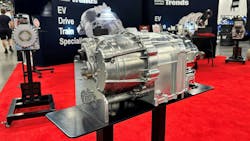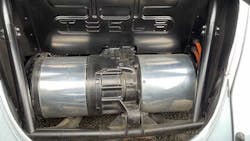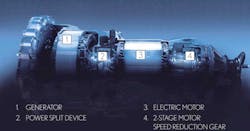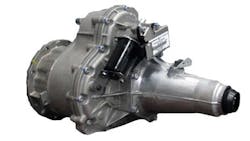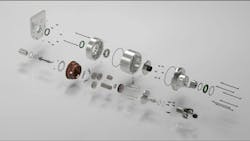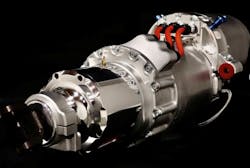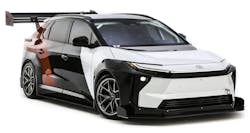SEMA Debut: THUNK’s Model 3 Traction Drive Fits in Trans Tunnels
What you'll learn:
- A number of options are available for traction motors and drive units for EV conversions, depending on drive wheel arrangement.
- In-tunnel drives preserve the driveline and open up engine compartments for HV traction batteries and other equipment.
- THUNK unveils a first at SEMA 2025 — an in-tunnel drive that uses a 300HP Tesla Model 3/Y motor and inverter.
The SEMA Show’s on
Forget that LS motor
An EV crate rules
When it comes to converting vehicles from internal combustion engines (ICEs) to electric motor propulsion (EV), two major challenges emerge: How/where to place the traction motor and where to place the high-voltage traction battery that’s of sufficient volumetric dimensions to meet minimum acceptable range requirements.
In some cases, that battery capacity (aka “range”) is “as much as will fit,” given the space available after de-ICEing (the process of removing engine, exhaust, and fuel systems, and other systems that supported engine operation) and in the spirit of keeping the original vehicle’s curb weight.
One of the main headaches is deciding how to connect the traction motor to the drive wheels, which could have originally been driven as front-wheel drive, rear-wheel drive, or four/all-wheel drive. Some conversion folks prefer to K.I.S.S. and connect a traction motor directly to the input shaft of the vehicle’s original transmission, retaining the remainder of the driveline; in certain cases, also retaining the clutch for easier gear shifts.
With the massive and instantaneous torque at low RPM of an electric motor, it’s not unusual for stock transmissions to get shredded if not beefed up, and with the high RPM capability of the traction motor, transmission-bearing speed limitations can easily be exceeded, fragging the tranny.
In the case of front-wheel drive, the Nissan Leaf has found popularity in that the entire “motor stack” can be fitted under most hoods/bonnets. For rear-drive vehicles, the Tesla LDU (Large Drive Unit) or SDU (Small Drive Unit) is typically fitted to vehicles with independent rear suspensions (including VW Bugs, Fig. 1). Some fabrication-brave souls replaced their original live-axled suspensions with a fabricated De Dion setup, which happened to be used in the Ford Ranger electric pickup of the late 90s.
Ford made a feeble attempt at an electric crate motor, announcing the “Eluminator” at SEMA a few years ago. However, Ford performance turned it into E-lemon-hater with zero support, including failing to provide the larger internal busbars of the rear unit as an over-the-counter part.
That’s because Eluminator was a front-drive unit with significantly derated power and duty cycle. A value engineering zealot decided to save $0.30 in copper by narrowing the internal bars feeding the stator from the inverter (if you can get me a half dozen internal busbars, please hit me up by email; I have three E-lemon-hater drive units I need to beef up).
In-Tunnel Solutions
For four-wheel drive, particularly the Land Rover crowd, a Tesla LDU is fitted sideways in the transmission tunnel, with the drive unit reworked to have a shorter reduction ratio (around 4.5:1). It has Tesla’s stock open differential replaced with a limited slip unit. The former axle stubs are now fitted with a forward and rearward pair of driveshafts to run the front and rear axles.
A sideways Tesla LDU is a bit unwieldy and not well suited to a rear-drive conversion candidate, so a better alternative for in-tunnel for less cavernous cars was needed. The DIY community has come up with the idea of using the CVT from a Lexus Hybrid (Fig. 2).
It looks very similar to an automatic transmission, fits in many transmission tunnels though it’s very bulky. There are two integrated electric motors for exploitation as drive motors, the front one formerly being the generator in the motor-generator part of the CVT that simply gets its input shaft locked mechanically so that it has something to react against.
In my travels, I’ve picked up a few other in-tunnel traction drive solutions for future EV conversion projects, from canceled programs and as low-mileage salvage rescues. The first, found commercially in the Ford Transit Connect Electric van, and the FUSO eCanter, is a combination of a Remy (now Borg-Warner) HVH-250 traction motor connected to a Borg-Warner 32-01 longitudinal gearbox that has a 3:1 ratio (3:1 torque, 1:3 speed).
The B-W 32-01 (Fig. 3), like most high-efficiency gearboxes, uses helical gears, which give it a bit of a wonky offset since the motor shaft and the first-stage reduction gear shaft are inches apart. However, it does have a TH-400 output spline and yoke that most driveshaft shops know fairly well.
Another approach is to use a planetary gear set behind various traction motors, with offerings from Oberaigner (which I have mated with a Remy HVH-250 again) or Torque Trends, exploded view in Figure 4. The problem with these is that they need a $5,000-$25,000 traction motor (the HVH was over $13k, new) and none offered jellybean Tesla traction motors, made by the millions, as an option.
A couple of years ago, reVolt Systems announced a sexy-looking Torque Trends setup that featured an inline Tesla Model S motor, along with the Tesla drive unit’s inverter repackaged, so it too was inline. But it was offset up from the centerline of the assembly (Fig. 5) with the intentions of more or less residing it in the ICE’s transmission tunnel. The 450-kW unit sells for $40k from Legacy EV.
With the Tesla Model 3 and Y being produced like jellybeans, it was just a matter of time before their traction motor would be used in EV conversions. M3/Y drive units have been used in conjunction with reverse-engineered VCUs for conversions with independent, or De Dion, suspensions. However, this year’s SEMA show unveils a new entrant in the tunnel drive space, freeing up former engine compartments for the HV traction battery.
Who’d a THUNK It?
THUNK, located in Westchester, N.Y., has collaborated with Torque Trends to produce a relatively compact tunnel drive. It features a 3:1 planetary gear box that’s coupled directly to a refurbished ~300 HP “10990” or “10980” Tesla motor from Model 3 or Model Y (Fig. 6).
The traction inverter, formerly integrated into the M3/Y drive unit, is repackaged such that it can be remotely located from the traction motor. It’s interconnected by the three motor phase cables and a few signal lines for such things as the motor resolver and, I’m guessing, the phase-current sensors. The motor requires oil cooling; thus, a substantial portion of the design involved the routing of oil for the stator windings and the two bearings that support the motor rotor.
Pricing for the “THUNK3” comes in at less than half that of the Model S tunnel drive being sold by Legacy EV — it’s about the price of a blown LS crate motor (let’s see you get 90 mpgE with one). Units are built to order with an expected turnaround time of about 6-8 weeks.
This week’s SEMA show starts today, November 4, and runs through November 7 at the Las Vegas Convention Center. The industry trade show is open to the general public only on Nov. 7. A prototype of THUNK’s tunnel drive can be found at Torque Trends’ booth, number 24713, in the EV and Future Propulsion area of the show.
If you can’t make it to SEMA, we’ve gotcha covered...here’s the booth handout sheet from THUNK as a download:
Toy-oughta
And, one more thing.... while late to the party, Toyota seems to have brilliantly driven off all of the “paper hands” (in WSB Ape-Speak) in electric vehicles with their worldwide anti-EV campaign. Cancellations and delays in EV programs by many crayon-eating Western OEMs (certainly not the “diamond hands” Chinese) stemmed from Toyota’s lobbying against EV tax credits and emissions regs.
Toyota now seems to now be stepping up its game (apart from the decades-long tiresome “solid-state battery is coming soon” announcements) with the recent unveiling of their beautimous Corolla EV Concept, and the unveiling of the bZ Time Attack Concept, also at this week’s SEMA show (Fig. 7):
“The car produces more than 400 horsepower from electric motors tuned by Toyota's research and development team. The production version of this [bZ] platform delivers 338 horsepower and a 0–60 mph time of 4.9 seconds. The concept features a full motorsport suspension and braking system, including TEIN coilovers, Alcon brakes with Hawk pads, and a roll cage made from FIA-spec 4130 chromoly. It rides on 19×11-inch BBS Unlimited wheels with 305/30ZR19 Continental Extreme Contact Sport 02 tires.
The car's body is widened by six inches and lowered by six inches compared with the production version. It includes a complete aerodynamic package with a rear wing, side skirts, front splitter, and rear diffuser. Toyota used laser scanning, computer-aided design, and large-scale 3D printing to create the body panels, fender arches, and aerodynamic components.” — msn.com
GM-oughta
OK GM, your turn, now that your pro-smog pal has upped the ante for EVs. Don’t be a bagholder. Give us a Chevy Bolt Z/28 where you take that 2027 LFP-batteried garden slug you just released, throw in a high-discharge “hi-C” NMC battery pack, the 338HP drive unit from the Blazer EV RS, a widebody kit, a stupid-high zero-AoA rear spoiler (“they” won’t know it does nothing and is set to minimum drag), a lowered suspension that rivals a Z06 in handling, and fat meats on all fours, cuz three miles per kWh while lookin’ fine, and hangin’ the tail out on the track, is as good as life gets for us car people.
Like our elections, American car offerings have been boring and dysfunctional choices — pick the better of the worst. Oh yeah, bring back the Shock and Cayenne Orange colors...and those silly ’69 Z/28 Camaro hood stripes.
Wouldn’t hurt my feelings if it was AWD and 400+ HP. Use your imaginations for a change... pony cars were overclocked autists’ sh!tboxes back in the day, so the new Bolt is the perfect platform for a Z/28 variant. It’d be a fun little, semi-environmentally responsible (so you can save face with your Tokyo buds and laugh over shots of sake, about the two extra trowel-scoops of coal it burns per charge versus Garden Slugium) pocket rocket.
Do it to it. YOLO,
-andyT
Andy's Nonlinearities blog arrives the first and third Monday Tuesday of every month. To make sure you don't miss the latest edition, new articles, or breaking news coverage, please subscribe to our Electronic Design Today newsletter. Please also subscribe to Andy’s Automotive Electronics bi-weekly newsletter.
About the Author
Andy Turudic
Technology Editor, Electronic Design
Andy Turudic is a Technology Editor for Electronic Design Magazine, primarily covering Analog and Mixed-Signal circuits and devices. He holds a Bachelor's in EE from the University of Windsor (Ontario Canada) and has been involved in electronics, semiconductors, and gearhead stuff, for a bit over a half century.
"AndyT" brings his multidisciplinary engineering experience from companies that include National Semiconductor (now Texas Instruments), Altera (Intel), Agere, Zarlink, TriQuint,(now Qorvo), SW Bell (managing a research team at Bellcore, Bell Labs and Rockwell Science Center), Bell-Northern Research, and Northern Telecom and brings publisher employment experience as a paperboy for The Oshawa Times.
After hours, when he's not working on the latest invention to add to his portfolio of 16 issued US patents, he's lending advice and experience to the electric vehicle conversion community from his mountain lair in the Pacific Northwet[sic].
AndyT's engineering blog, "Nonlinearities," publishes the 1st and 3rd monday of each month. Andy's OpEd may appear at other times, with fair warning given by the Vu meter pic.
